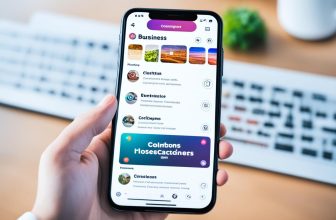As the digital landscape continues to evolve, the role of social media marketing as a pivotal tool for increasing brand awareness on social media is more prominent than ever. With the potential to reach over 4 billion individuals worldwide, social media platforms offer brands a vast stage to display their identity, connect with customers, and refine their social media strategy without relying solely on paid advertising methods.
Creating a successful social media content marketing plan isn’t just about regular posts, it’s about mapping out a thoughtful strategy that places your brand in the natural line of sight for your ideal consumers. By engaging authentically and leveraging platform-specific trends and analytics, companies can deliver content that resonates deeply with users, encouraging interaction and shareability – the cornerstones of organic growth on social media.
Understanding the different behaviors and expectations on each social network is crucial. A singular message spread across various platforms won’t cut it. Instead, acknowledge the unique attributes of each – the storytelling nature of Facebook, the aesthetic draw of Instagram, the concise punch of Twitter – to tailor content perfectly designed for engagement and amplification.
Key Takeaways
- Strategize organically to enhance brand visibility on social media.
- Integrate firm knowledge of different platforms into your social media strategy.
- Curate social media content marketing plans that resonate with your audience.
- Engagement and shareability should be at the heart of content creation.
- Leverage analytics and trends to stay ahead in the social media game.
- Customize content to harness the unique strengths of each social media platform.
Choosing the Right Social Media Platforms for Your Brand
Enhancing your brand’s presence on social media is no small feat—it entails selecting the most conducive platforms for brand visibility and engagement. Each network comes with its own nuances and audience types, making it essential to discern where your target audience spends their time and how they interact with content. The sophistication of social media analytics today can offer invaluable insights into platform performance, guiding a brand’s strategic decisions to foster greater brand awareness.
Identifying Your Target Audience’s Preferred Channels
The first crucial step in formulating a social media strategy is to identify where your target audience is most active. Researching demographics and user behavior on various social networks lays the foundation for connecting with your intended audience. A granular understanding of their social media habits and preferences enables brands to create engaging content tailored specifically to the channels their customers prefer.
Maximizing Your Efforts with Strategic Platform Selection
A successful social media strategy doesn’t necessitate presence on every platform. Instead, it requires a focused approach to invest time and resources proficiently. By narrowing down social media efforts to platforms that yield the highest engagements and align with marketing goals, brands can more efficiently increase their social media for brand awareness.
How Engagement Varies Across Different Social Networks
Different social media platforms serve different purposes and nurture varied forms of engagement. Twitter’s fast-paced environment is ideal for real-time updates and crisp messages, while Instagram’s visually rich platform is perfect for high-quality imagery and storytelling. Understanding the unique strengths and user expectations of each can significantly help in tailoring your approach to maximize brand visibility on social media.
Employing social media analytics tools provides a clearer snapshot of engagement metrics and audience behavior. Detailed analytics can pinpoint what type of content resonates best and at what times your audience is most active, offering strategic advantages for content scheduling and targeted campaigns.
| Platform | User Demographics | Content Type | Engagement Features |
|---|---|---|---|
| Millennials & Gen Z | Images, Stories, Videos | Likes, Comments, Shares, DM | |
| Wide range, news-focused | Short-form text, Images, Polls | Retweets, Replies, Likes | |
| Gen X & Boomers | Mixed media, Link shares | Reactions, Comments, Shares | |
| Professionals & B2B | Articles, Company updates | Reactions, Comments, Shares |
Creating Compelling Content to Spark Engagement
The landscape of social media engagement has drastically evolved, with users craving more than just surface-level interactions. It’s evident that content which resonates on a personal level, has a clear identity, and maintains relatability sparks meaningful engagement. As brands battle for consumer attention, the need for dynamic social media content marketing strategies becomes more apparent. In light of this, there are key areas of focus when crafting content that captivates and engages.
Implementing Visuals for Higher Interaction Rates
Visual storytelling stands as a cornerstone of successful social media advertising. Images and videos are the conduits through which narratives unfold, emotions are stirred, and connections are forged. To thrive, brands must master the art of visual composition, as it has proven to prompt higher interaction rates across various social media platforms.

The Importance of Tailoring Content to Each Platform
Understanding the unique environments of each platform allows for tailored, effective marketing. Recognizing the constraints and advantages, such as Twitter’s brevity or Instagram’s visual-centric space, ensures that your content is not just seen but is also felt and interacted with. The infographic below distills the essence of each major platform, offering insights into their best practices:
| Platform | Content Focus | Engagement Features |
|---|---|---|
| Concise, timely messages | Hashtags, retweets | |
| High-quality visuals, stories | DMs, polls, swipe-up links | |
| Diverse content, from text to live videos | Reactions, comments, shares | |
| Professional content, articles | Endorsements, comments |
Utilizing User-Generated Content to Boost Authenticity
In today’s digital marketplace, authenticity reigns supreme. Incorporating user-generated content not only humanizes a brand but also strengthens trust. When real users advocate for a product or share their experiences, it not only endorses the brand but also motivates others to engage and share. This organic form of social media advertising can lead to a domino effect, vastly expanding reach.
- Customer reviews and testimonials
- User-submitted photos and videos
- Engaging with user content through reposts and features
By placing these pillars at the heart of your social media strategy, you’re well on your way to creating an environment ripe for engagement and community growth. Remember that the essence of social media is to be just that — social. Interact, inspire, and innovate to keep your audience engaged and invested in your brand’s journey on social media.
Strategies for Encouraging Social Sharing and Virality
The landscape of social media influencer marketing is continuously evolving, with strategies focused on optimizing social media engagement and creating a ripple effect of brand visibility. One pivotal element fostering this growth is the seamless blend of content that resonates on a personal level with users, compelling them to share it with their networks.
Savvy brands approach social media strategy with a clever mix of humor, value-based messaging, and content that sparks emotional responses. For example, quick-service restaurant chain Wendy’s has become renowned for its sassy social media persona, setting a high bar for brand interaction on platforms such as Twitter and garnering significant shareability.

Key to the success of such strategies is the ease with which content can be shared. Social sharing buttons should be prominently displayed and functional across all devices, inviting users to disseminate content widely. Additionally, strategic collaborations with influencers can project the brand into broader audiences, often leading to viral content that can exponentially increase social media engagement.
- Launching hashtag campaigns that encourage user participation
- Hosting giveaways that incentivize sharing and following
- Creating challenges that promote user-generated content and sharing
- Partnering with influencers to co-create content that’s both authentic and shareworthy
- Utilizing analytics to understand what content performs best and leveraging those insights for future campaigns
Ultimately, it is the alignment of these strategies with the brand’s core values and the interests of its target demographic that propels a brand’s content from mere visibility to viral sensation. By weaving these elements together into a cohesive strategy, brands can tap into the potent word-of-mouth engine that is influencer marketing and the social sharing culture.
Incorporating Social Media Influencers into Your Strategy
In an era marked by the influential power of social media personalities, a brand’s affiliation with the right influencers can lead to a substantial increase in brand awareness and image. Delving into social media influencer marketing does not simply skyrocket your brand visibility on social media; it also evolves your promotional tactics to be more relational and trust-based.
Collaborating with Influencers for Extended Reach
Mastering the art of collaboration with individuals who possess a loyal following on platforms such as Instagram, YouTube, and TikTok can open doors to audiences that were previously untapped by traditional marketing efforts. These influencers have already built an environment of credibility and authority among their followers, and by associating with them, a brand can bask in the glow of their influence. Such partnerships in social media advertising often transcend the promotional phase, resulting in a higher rate of audience engagement and conversion.
Learning from Influencer Engagement to Improve Content
Engagement remains the cornerstone of a thriving social media strategy. By observing and understanding the engagement an influencer incites, brands can garner valuable insights into consumer behavior and preferences. This intelligence can refine a brand’s content strategy, ensuring that it remains appealing and relevant to the target audience. Learning from influencers also involves recognizing the nuances that make their content resonate, thereafter integrating similar elements to bolster brand messaging and connectivity with the audience.
Developing Beneficial Partnerships and Brand Advocates
Enduring, mutually rewarding partnerships with influencers are pillars of a robust influence-based marketing strategy. Beyond one-off campaigns, investing in ongoing collaborations can endow a brand with advocates who are vested in the brand’s journey. Aligning with influencers who share the brand’s values and ethos creates authentic connections with their following, which can amplify trust and loyalty toward the brand. By fortifying these relationships, brands do not just secure short-term traffic; they cultivate a coalition of support that could lead to sustainable growth and a fortified presence on the digital social sphere.
FAQ
Increasing brand awareness organically on social media involves a strategic social media marketing plan that engages users with compelling content tailored to each platform. It also includes consistently communicating the brand’s voice and values, engaging with the audience through comments and messages, and utilizing social media content marketing tactics to create shareable, valuable content.
Choose platforms where your target audience is most active and engaged. Analyze platform-specific social media analytics to understand demographic presence and user preferences. Prioritize platforms that align with your brand’s content strengths and marketing goals for effective brand visibility on social media.
Engagement varies across social networks based on the platform’s focus and audience behavior. Image-driven networks like Instagram may see higher engagement with visual content, while Twitter may benefit from timely, conversation-driven posts. Understanding these nuances is key to optimizing social media strategy for brand awareness.
Visuals such as images and videos are critical in capturing users’ attention and generating higher interaction rates. They make content more engaging and shareable, which is essential for boosting social media engagement and increasing brand awareness.
Content should be crafted to fit the unique characteristics of each platform, considering factors like character limits, visual emphasis, and the user’s content consumption preferences. This customization helps increase the relevance and effectiveness of the content, thereby enhancing user interaction and sharing.
How can brands use user-generated content effectively?
Brands can feature user-generated content to showcase real-life product applications, foster community, and enhance brand authenticity. Encouraging customers to share their experiences, hosting contests, and featuring customer stories are ways to integrate user content into a brand’s social media strategy.
Brands can create content that is designed to evoke emotions, align with user values, or include humor to increase shareability. They can also use social media influencer marketing, strategically incorporate hashtags, and develop content that encourages user participation, such as challenges or polls, to amplify reach.
How do brands collaborate with influencers to increase visibility?
Brands can partner with influencers whose followers match their target audience to promote their products or services. This can include sponsored content, affiliate marketing, product reviews, or joint campaigns, effectively extending reach and enhancing brand reputation through trusted personalities.
Brands can gain insights into effective content types, posting times, and audience preferences by analyzing influencer engagement metrics. This data can inform a brand’s content strategy and help optimize future social media campaigns for better performance and engagement.
How can brands develop beneficial partnerships and brand advocates through influencers?
Brands can develop beneficial partnerships by aligning with influencers who share their brand values and by engaging in collaborative efforts such as giveaways, affiliate programs, and exclusive content. These partnerships not only extend reach but can also foster long-term brand advocates among the influencer’s following.







